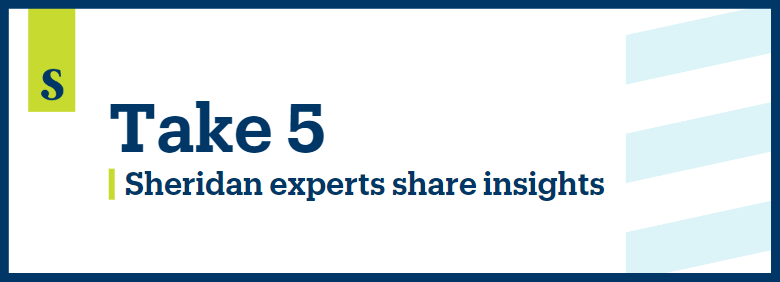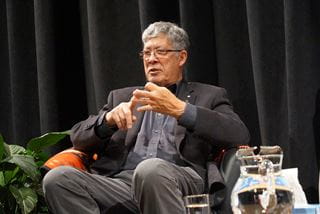
How can employers work to create inclusive, diverse and equitable workplaces?
 by Marianne Sy-Lucero â Nov 27, 2023
by Marianne Sy-Lucero â Nov 27, 2023 
In Take 5, šėÁŦÉįĮøâs thought leaders share their expert insight on a timely and topical issue. Learn from some of our innovative leaders and change agents as they reflect on questions that are top-of-mind for the šėÁŦÉįĮø and broader community.

For the third consecutive year, šėÁŦÉįĮø returned to Forbesâ list of Canadaâs Best Employers for Diversity in July â ranking 12th overall and the only college on the list of 150 organizations. Earlier this year, šėÁŦÉįĮø also topped Forbes Magazineâs annual ranking of Canadaâs Best Employers, which included 300 employers across 37 industries.
In this installment of Take 5, šėÁŦÉįĮøâs Manager, EDI Knowledge Mobilization, Alicia Sullivan discusses the steps organizations should take to foster equity, diversity and inclusion (EDI) in the workplace, the important role employees play in holding leadership accountable, the impact of EDI on employee retention and more.
1. What do you believe are the necessary steps organizations must take to create a workplace that values and embodies EDI?
The first thing employers need to consider is a systems approach where the entire organization is involved in some capacity. The responsibilities should not be solely with your EDI/HR department.
Tone at the top is essential. Senior leadershipâs support and commitment to explicitly embedding EDI as part of the organizationâs overall strategy is a critical first step for fostering equity, diversity and inclusion in the workplace. Their endorsement and participation in EDI efforts demonstrates to employees the commitment of the organization. If senior leadership doesnât express this level of commitment, employees may be tentative in their support of the strategy and may not trust the process.
Organizations must also invest resources into EDI efforts since organizational performance is intricately tied to effectively managing diverse talent. Allocating sufficient resources to operationalize EDI plans â whether it's providing physical space, adequate human resources or budget â will give employees the means to complete the work that needs to be done. With this investment, an EDI leader with access to senior leadership, such as šėÁŦÉįĮøâs Vice President Inclusive Communities, should have a seat at the decision-making table.
2. What advice do you have for employers who want to implement EDI policies and procedures in their organizations?
When I think about the trajectory of EDI over time, weâre starting from a place where there have been hundreds of years of systemic inequities and bias built into our systems and interpersonal relations. So, while many organizations are waiting for the âright approachâ, unfortunately there are no manuals or quick fixes on how to âdo EDI the right wayâ. Second, the fear of failure is very real, and organizations often donât get started because they want to have the ideal conditions in place before doing so. But that is a mistake. Organizations need to assess where they are at and just get started. Things generally evolve from there.
More importantly, organizations need to listen to all of their stakeholders. Having that dialogue will unearth issues within the organization; whatâs working well and whatâs not working well, especially as they relate to the experiences of equity-deserving groups. For example, some years ago šėÁŦÉįĮø responded to feedback from students and employees, and reassigned some washrooms as gender neutral to be inclusive of folks who identify as non-binary. By having meaningful conversations, we can identify any pain points or gaps, and take action. Initiatives and programs tend to naturally emerge as we gain a better understanding of the needs of our community members.
"Many organizations are waiting for the âright approach,â...but that is a mistake. Organizations need to assess where they are at and just get started. Things generally evolve from there."
Organizations also need to be prepared to deal with backlash when policies and procedures are implemented to amend historical and contemporary inequities. There will be people who ascribe to a zero-sum mindset and feel that addressing barriers for members of equity-deserving groups will limit opportunities for them.
Itâs important for organizations to create a plan of action before backlash happens. One way to do that is to have data and use it to justify decisions based on facts. When leaders have data about their organizationâs demographics, employee experiences, pay and attrition rates for different groups, etc. there will be evidence to explain why these programs and policies are implemented.
Ultimately, we want to create a culture where EDI is embedded and everyone knows it, believes it, and is living it. Over time, it will become part of the organizationâs DNA and the people will want to continue making it a better space for everyone.
3. What can employees do to ensure their leadership is held accountable for fostering EDI in the workplace?
There is so much that employees can do. As employees, we donât always recognize the power we have as a collective, and we often donât effectively leverage this power to hold senior leaders accountable for their decisions. One thing that we can do as employees is take up space. Take a seat at the table when it is open, and when a seat is not provided for you, bring your own seat and find opportunities to be in those spaces where decisions are made.
In terms of publicly holding leaders accountable, some ways include participating in town halls, staff meetings or consultations where employees can ask questions and get answers, allowing them to better understand and appreciate organizational decisions. These spaces also create opportunities for providing feedback to leaders for their consideration.
"One thing that we can do as employees is take up space. Take a seat at the table when it is open, and when a seat is not provided for you, bring your own seat and find opportunities to be in those spaces where decisions are made."
On the other hand, employees may also take advantage of anonymous mechanisms to provide open and honest feedback. Can you imagine if everyone in an organization were to complete an employee engagement survey? This would make for a rich reservoir of information to inform leadership about EDI practices that are working and those that need improving in the workplace.
For those who fear reprisal for expressing their perspectives as individuals, speaking collectively as a group (e.g. Employee Resource Group) may be a great option. Thereâs always more power in numbers when we approach the table as a collective voice.
4. How does diversity contribute to employee retention, and can it have a long-lasting impact?
Diversity is one of the pillars to retain employees. When thereâs diverse representation in an organization, people will see themselves reflected across different levels in the organization, especially in leadership, which encourages them to stay. The next pillar is fairness. When employees perceive that they have a fair chance for professional development and promotion, they are more likely to feel satisfied and stay.
âDiversity is one of the pillars to retain employees...The sealer of the deal for employee retention is inclusion. When people feel a sense of belonging, (employees) are more willing to stay with an employerâ
The sealer of the deal for employee retention is inclusion. When people feel a sense of belonging, they are more willing to stay with an employer. Added elements include policies and a culture around anti-racism, not tolerating discrimination and harassment, and a commitment to decolonization. Itâs a complex package, but it is essential to making employees feel that this is a place where theyâll want to spend a long time developing their careers and making meaningful contributions.
Embedding and sustaining EDI principles and practices is essential for todayâs organizations. We must keep working on being more equitable and inclusive and increase diverse representation in senior roles. This is hard, complex long-term work.
5. In the past year, šėÁŦÉįĮø launched Canadaâs only English-language Knowledge Mobilization Dissemination Centre, ranked 12th on Forbesâ 2023 list for Canadaâs Best Employers for Diversity and continues to be committed to CICanâs 50-30 Challenge. Recognizing that šėÁŦÉįĮø is continuing to implement more equity, diversity and inclusion practices in the workplace, what is the institution doing particularly well right now?
The first thing I would say is that šėÁŦÉįĮøâs commitment to student success is second to none. It is one of the top colleges in Ontario for a reason â its employees. At the core, our employees contribute to student success, from student affairs staff providing essential services to our students to faculty members developing and delivering a curriculum catered to diverse learners.
As a signatory of the 50-30 Challenge, šėÁŦÉįĮø has intentionally worked towards diversifying its workforce, including leadership and its Board of Governors. Through this intentional work, šėÁŦÉįĮø was selected as one of two colleges in Canada to represent CICan as an EDI Knowledge Mobilization Centre. This has allowed us to support organizations across Canada and within our catchment area in Peel and Halton with their EDI strategies to help them make progress towards more diverse representation in leadership and on boards.
šėÁŦÉįĮø also offers foundational training and education on EDI to all of its employees. This includes training on unconscious bias, equitable practices, accessibility and intercultural competency. We are supporting our entire employee base with education and awareness around EDI which has helped to create more dialogue, cultural sensitivity and a greater understanding and appreciation of differences.
Iâd be the first to say that training and education is not enough thoughâ it doesnât always translate into action. However, šėÁŦÉįĮø does a good job of having anchoring initiatives that help to embed learning. For example, we have several Employee Resource Groups that support employeesâ sense of belonging. Many of the conversations and initiatives from these groups then circle back into the college ecosystem, providing opportunities for leaders to understand whatâs working, learn about ongoing concerns, and ultimately take action to address the issues.
Alicia Sullivan is a dedicated leader and EDI professional who currently serves as Manager, Equity, Diversity and Inclusion (EDI) at College and Institutes Canadaâs (CICan) EDI Knowledge Mobilization and Dissemination Centre located at šėÁŦÉįĮø College. She provides operational and programmatic oversight for a Canada-wide advising program to advance the objectives of the Government of Canadaâs 50 â 30 Challenge Program. Alicia provides leadership, coaching and mentorship to a team of EDI advisors across 4 Regional College Hubs and works more broadly with over 20 English-speaking colleges and institutes across Canada, helping them to identify and address systemic barriers to create more diverse, equitable and inclusive workplaces in colleges. She has held previous roles at šėÁŦÉįĮø including, Project Manager of a game-changing student experience program and was the Equity, Diversity and Inclusion Coordinator. She is currently a part-professor of Sociology and serves as volunteer to several Halton Region organizations as an EDI advisor, helping them to address barriers faced by members of equity deserving groups.
Interested in connecting with Alicia Sullivan or another šėÁŦÉįĮø expert? Please email communications@sheridancollege.ca
This interview has been edited for length and clarity.
Media Contact
Meagan Kashty
Manager, Communications and Public Relations




